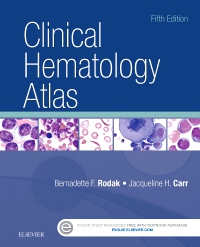
Clinical Hematology Atlas - Elsevier eBook on VitalSource, 5th Edition
Elsevier eBook on VitalSource

Help your students learn to accurately identify cells at the microscope with Clinical Hematology Atlas, 5th Edition. An excellent companion to Rodak's Hematology: Clinical Principles & Applications, this award-winning atlas offers complete coverage of the basics of hematologic morphology, including examination of the peripheral blood smear, maturation of the blood cell lines, and information on a variety of clinical disorders. Nearly 500 photomicrographs, schematic diagrams, and electron micrographs vividly illustrate hematology from normal cell maturation to the development of various pathologies so students can be certain they are making accurate conclusions in the lab.
Newer Edition Available
Clinical Hematology Atlas Elsevier eBook on VitalSource
-
- NEW! Appendix with comparison tables of commonly confused cells includes lymphocytes versus neutrophilic myelocytes and monocytes versus reactive lymphoctyes to help students see the subtle differences between them.
- NEW! Glossary of hematologic terms at the end of the book provides a quick reference for students to easily look up definitions.
- Schematic diagrams, photomicrographs, and electron micrographs are found in every chapter to visually enhance the understanding of hematologic cellular morphology.
- Chapter on normal newborn peripheral blood morphology covers the normal cells found in neonatal blood.
- Morphologic abnormalities are covered in the chapters on erythrocytes and leukocytes, along with a description of each cell, in a schematic fashion.
- Chapter on body fluids illustrates the other fluids found in the body besides blood, using images from cytocentrifuged specimens.
- The most common cytochemical stains, along with a summary chart for interpretation, are featured in the leukemia chapters to help students classify both malignant and benign leukoproliferative disorders.
- Chapter featuring morphologic changes after myeloid hematopoietic growth factors is included in the text.
- Small trim size, concise text, and spiral binding make it easy for students to reference the atlas in the laboratory.
- Educator resources on the Evolve companion site include an image collection.
- Student resources on the Evolve companion site feature student review questions and summary tables to further enhance their learning experience.
-
- NEW! Appendix with comparison tables of commonly confused cells includes lymphocytes versus neutrophilic myelocytes and monocytes versus reactive lymphoctyes to help users see the subtle differences between them.
- NEW! Glossary of hematologic terms at the end of the book provides a quick reference to easily look up definitions.
-
Section 1: Introduction
1. Introduction to Peripheral Blood Film ExaminationSection 2: Hematopoiesis
2. Hematopoiesis
3. Erythrocyte Maturation
4. Megakaryocyte Maturation
5. Neutrophil Maturation
6. Monocyte Maturation
7. Eosinophil Maturation
8. Basophil Maturation
9. Lymphocyte MaturationSection 3: Erythrocytes
10. Variations in Size and Color of Erythrocytes
11. Variations in Shape and Distribution of Erythrocytes
12. Inclusions in Erythrocytes
13. Diseases Affecting ErythrocytesSection 4: Leukocytes
14. Nuclear and Cytoplasmic Changes in Leukocytes
15. Acute Myeloid Leukemia
16. Precursor Lymphoid Neoplasms
17. Myeloproliferative Neoplasms
18. Myelodysplastic Syndromes
19. Mature Lymphoproliferative Disorders
20. Morphologic Changes after Myeloid Hemopoietic Growth FactorsSection 5: Miscellaneous
21. Microorganisms
22. Miscellaneous Cells
23. Normal Newborn Peripheral Blood Morphology
24. Body FluidsAppendix: Comparison Tables


 as described in our
as described in our 